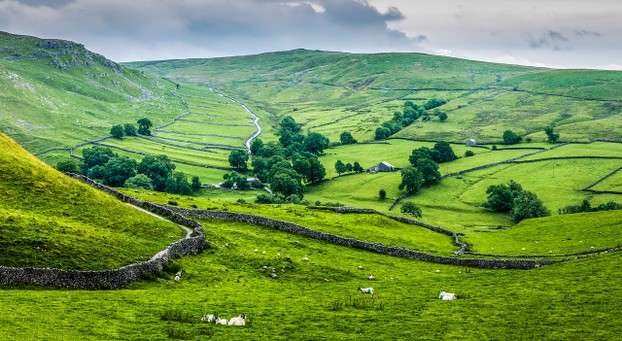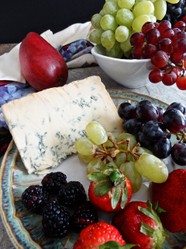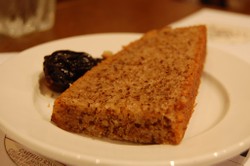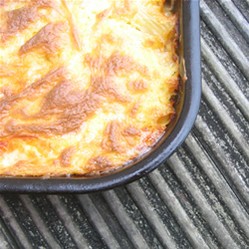Some time in the early Middle Ages a community of French monks moved northwards. Cistercians, a group who believed in silent,penitential lives, sought quiet, wild places for their contemplation. Unlike the Benedictines,who were gardeners, the Cistercians were shepherds, at home in the wild hills of Northern England. There they settled, thinking that their monastery was established until Christ's second coming, and there they made cheese,first from ewes' milk, then from cows' with some ewes' milk added for texture. And they were content.
But there came a day in 1540 when the tyrant Henry the Eighth, aided by Protestant fanatics,closed the monastery, stripped it of its goods and drove the monks from their homes. But before they left the kindly monks gave the devoutly Catholic locals, who hated Henry's "reforms", the method for making Wensleydale Cheese, which is still made today in their memory.
Move on a few hundred years and I received a telephone call. My second son,Peter,an avid foodie who loves cooking and cheese,had been working as a Summer school English lecturer in a college near Wensleydale and had been able to take a trip with the students to the creamery at Hawes where the cheese is made. He wanted to share his experience with his cheese-loving father. His one regret was that he would have liked to have spoken to my father, also a cheese lover, and bring him a sample, but by then my father was no longer with us. But a good day nevertheless.
Wensleydale is now a cows' milk cheese drawn from cows that feed on the sweet grass of the limestone pastures of the Pennine Hills, which you see below. It is a white,crumbly cheese great for cheese on toast. It has a flavour that is said to make it go well with fruit, sweet fruits go well with it, and sometimes are included into the cheese itself. This is a great cheese to serve at parties, especially if it is enriched by fruit
I detect an affinity of taste and texture with the gorgeous cheese Cheshire, but Cheshire, which is great for cheese on toast, one of my favourites, comes from milk from cows reared on the sandy, but well manured soils of the county whose northern border is one mile south of my home.













 Pilgrimage. A review20 days ago
Pilgrimage. A review20 days ago
 Leo the Fourteenthon 05/09/2025
Leo the Fourteenthon 05/09/2025
 The Melsonby Hoardon 03/25/2025
The Melsonby Hoardon 03/25/2025



Comments
Generally fruit is added to the cheese making mixture, but fruit and cheese are eaten at lunch. Recently I ate a lunch which included goats cheese andbgrapes.
Thank you for your comment below in answer to my previous observation and question.
Cheese slices and separate fruit slices are my experience. My first experience with cheese enhanced by fruity chunks already in each slice comes with Wensleydale. I enjoy it that way.
Is it standard among British Isles-ers to munch cheese slices with fruity chunks inside or with separate fruit slices?
I eat already fruited cheeses
Thank you for your comment below, on Aug. 4, 2017, in answer to my previous, same-day observation and question.
Your answer advises us that "I have eaten Wenselydale with apricot and cranberry, and I found that they go beautifully together."
The cheese section of the grocery store where I do Friday shopping carries Wensleydale with apricot and Wensleydale with cranberry as colorful chunks already in them.
Do you eat already apricoted Wensleydale or do you eat Wensleydale cheese with a side order of apricots?
Few records survived, so we cannot say for certain, but goats prefer dry ground, and so damper pastures are more suitable for sheep and cattle than they are for goats. Maybe on the limestone areas of parts of Yorkshire [in North East England] there may have been some goat herding, but sheep seem to have been dominant. There are no records of goat herding among the monks, who concentrated on the larger market for sheep.
That first paragraph to the first subheading, Wensleydale, associates Cistercians ultimately more with cow moo-lk than with sheep.
Did the Cistercians or any other order avail themselves of goat moo-lk?
I think that it depended on individual monasteries.
Thank you!
Might there have been a trade network whereby Benedictines could buy from Cistercians and vice versa? Or must such purchases have been through area traders?
A film and online sources presented the Trappist monks at Our Lady of Atlas Abbey of the Médéa area at Tibhirine, Algeria, as doing some things themselves and getting other things through the local markets.
They probably bought anything that they could not produce themselves.
The first paragraph to the first subheading, Wensleydale, categorizes Benedictines as gardeners and Cistercians as shepherds.
Where did Benedictines get their sheep-related products from?